Finding the perfect hairstyle that combines beauty, practicality, and protection can transform your entire look and boost your confidence.
“25 Simple Braided Hairstyles for Black Women” is your comprehensive guide to discovering versatile, elegant, and easy-to-achieve braided styles that celebrate natural hair texture while offering lasting protection.
Whether you’re preparing for a special occasion, seeking a low-maintenance everyday look, or simply wanting to switch up your style, braided hairstyles offer endless possibilities that honor cultural heritage while embracing modern trends.
This article walks you through 25 stunning braided options, from classic cornrows to trendy knotless braids, complete with styling tips, maintenance advice, and inspiration to help you choose the perfect braid pattern for your lifestyle, face shape, and personal aesthetic.
Get ready to explore protective styles that not only look gorgeous but also promote healthy hair growth and give you the freedom to express your unique beauty.
Contents
- 1 1. Classic Box Braids
- 2 2. Cornrows
- 3 3. Knotless Braids
- 4 4. Fulani Braids
- 5 5. Feed-In Braids
- 6 6. Senegalese Twists
- 7 7. Havana Twists
- 8 8. Marley Twists
- 9 9. Ghana Braids
- 10 10. Jumbo Braids
- 11 11. Tribal Braids
- 12 12. Lemonade Braids
- 13 13. Micro Braids
- 14 14. Crochet Braids
- 15 15. Goddess Braids
- 16 16. Tree Braids
- 17 17. Passion Twists
- 18 18. Butterfly Locs
- 19 19. Stitch Braids
- 20 20. Bubble Braids
- 21 21. Braided Ponytail
- 22 22. Zig-Zag Braids
- 23 23. Braided Updo
- 24 24. Braided Bob
- 25 25. Mixed Braid Styles
- 26 Maintenance Tips for All Braided Styles
- 27 Choosing the Right Braid Style for You
- 28 Styling Accessories and Embellishments
- 29 Color Options for Braided Styles
- 30 Professional vs. DIY Braiding
- 31 Cost Considerations for Braided Styles
- 32 Hair Growth and Health While Braided
- 33 Conclusion
1. Classic Box Braids

Box braids remain one of the most timeless and versatile protective styles in Black hair culture.
This technique involves sectioning hair into small square or rectangular parts and braiding synthetic or natural hair extensions from root to tip.
Box braids offer incredible styling flexibility and can last anywhere from six to eight weeks with proper care.
Why Choose Box Braids
- Box braids provide excellent protection for natural hair by minimizing daily manipulation and reducing exposure to heat styling tools.
- The style works beautifully for all hair lengths and can be customized with various braid thicknesses to suit your preference.
- You can experiment with different colors, lengths, and parting patterns to create a look that’s uniquely yours.
- Box braids are incredibly low-maintenance once installed, requiring only basic nighttime care and occasional moisturizing.
Styling Versatility
- Pull your box braids into a high ponytail for an elegant, face-framing look that works for both casual and formal occasions.
- Create a braided bun by wrapping sections of braids around themselves and securing with bobby pins for a sophisticated updo.
- Style half-up, half-down by gathering the top section while letting the rest cascade down your back for effortless beauty.
- Add decorative beads, cuffs, or colored thread throughout individual braids to personalize your style and add visual interest.
2. Cornrows

Cornrows are traditional braids that lie flat against the scalp in straight lines or intricate geometric patterns.
This protective style has deep cultural roots and offers a sleek, polished appearance that can last several weeks.
Cornrows can be worn alone or serve as the foundation for other styles like weaves or wigs.
Design Possibilities
- Straight-back cornrows create a clean, uniform look that’s perfect for athletic activities or professional settings.
- Curved or zigzag patterns add artistic flair and showcase the braider’s skill while making your style stand out.
- Cornrow updos combine multiple rows that converge into buns or twisted styles at the crown for elegant occasions.
- Side-swept cornrows create asymmetrical designs that add dimension and modern edge to this classic technique.
Maintenance Tips
- Tie your cornrows with a silk or satin scarf at night to preserve the style and protect your edges from friction.
- Apply lightweight oil to your scalp every few days to prevent dryness and maintain healthy hair underneath.
- Avoid keeping cornrows in longer than four to six weeks to prevent matting and give your scalp a break.
- Cleanse your scalp with diluted shampoo or witch hazel on a cotton pad to remove buildup without disturbing the braids.
3. Knotless Braids

Knotless braids represent an evolved version of traditional box braids, starting with your natural hair and gradually feeding in extensions without the bulky knot at the base.
This technique results in a more natural-looking style that’s significantly lighter and places less tension on your scalp and edges.
Benefits Over Traditional Braids
- Knotless braids eliminate the tight knot at the root, reducing the risk of traction alopecia and tension headaches.
- The gradual feed-in technique creates a more seamless, natural appearance that looks like your hair is growing from your scalp.
- This style typically causes less scalp tenderness during and after installation compared to traditional box braids.
- Knotless braids move more fluidly and feel lighter, making them comfortable for extended wear and active lifestyles.
Styling Options
- Create goddess knotless braids by leaving the ends unbraided and curly for a romantic, bohemian aesthetic.
- Style shorter knotless braids into a sleek bob for a chic, modern look that frames your face beautifully.
- Combine different braid sizes throughout your head for a textured, multidimensional appearance.
- Accessorize with golden thread woven through select braids or decorative clips for added personality.
4. Fulani Braids
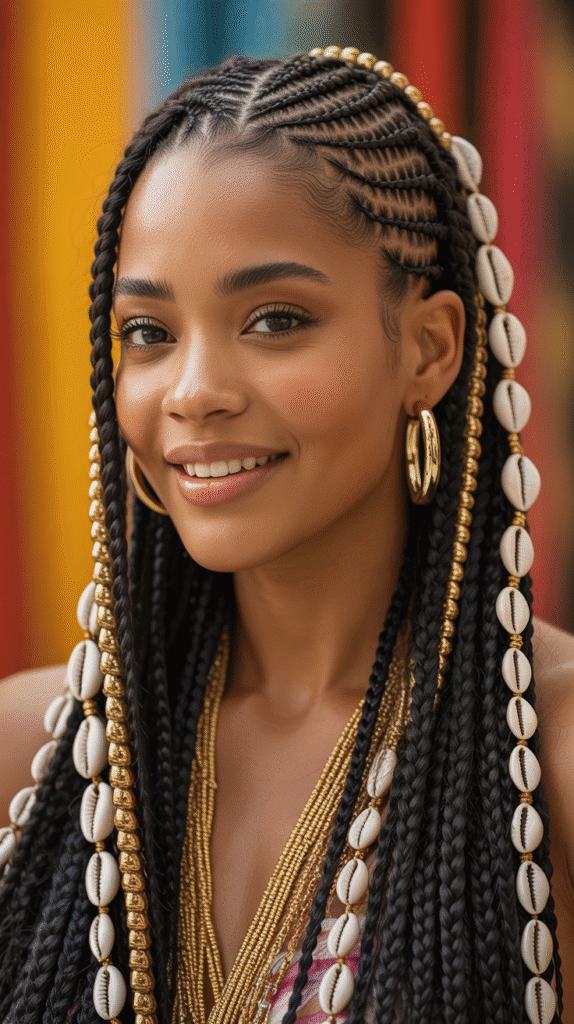
Fulani braids draw inspiration from the Fulani people of West Africa and feature distinctive elements like cornrows braided toward the back, a central braid, and decorative beads or cowrie shells.
This style beautifully combines cultural heritage with contemporary fashion, creating a striking and meaningful look.
Signature Elements
- The central braid running from front to back serves as the focal point and distinguishes Fulani braids from other styles.
- Side cornrows typically frame the face and temples, creating a flattering silhouette that highlights facial features.
- Decorative elements like beads, shells, rings, and thread honor the style’s cultural origins while adding personalization.
- Long hanging braids in the back provide length and movement, often styled with varied thicknesses for visual interest.
Cultural Significance
- Fulani braids connect wearers to centuries of West African tradition and celebrate the artistry of the Fulani people.
- The style represents a powerful statement of cultural pride and serves as a conversation starter about African heritage.
- Wearing Fulani braids with respect and knowledge of their origins honors the communities that originated this beautiful art form.
- Modern adaptations allow for creative expression while maintaining the essential elements that make Fulani braids distinctive.
5. Feed-In Braids
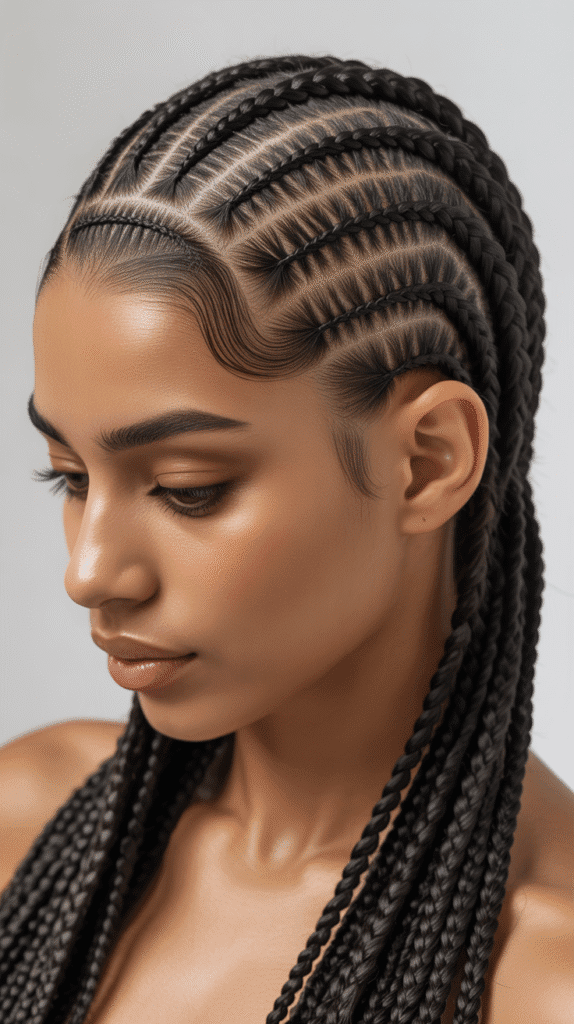
Feed-in braids use a technique where extensions are gradually added in small sections as you braid, creating a natural-looking taper from thin roots to thicker braids.
This method provides a flatter, more seamless appearance at the scalp while reducing tension and promoting healthier edges.
Technique Advantages
- The gradual addition of hair creates less bulk at the roots, resulting in a more natural and less obvious starting point.
- Feed-in braids distribute weight more evenly throughout the braid, reducing stress on individual hair follicles.
- This technique allows for precise control over braid thickness, creating perfectly tapered styles that look polished.
- The reduced tension at the hairline makes feed-in braids ideal for those with delicate edges or previous hair loss.
Popular Feed-In Styles
- Lemonade braids feature side-swept feed-in cornrows that cascade to one side in varying sizes for a trendy, asymmetrical look.
- Feed-in ponytail involves cornrows braided toward the crown that gather into a high or low ponytail with added length.
- Straight-back feed-ins create uniform rows from front to back with a clean, sleek appearance perfect for any occasion.
- Curved feed-in designs incorporate swooping patterns that add artistic dimension while maintaining the technique’s benefits.
6. Senegalese Twists
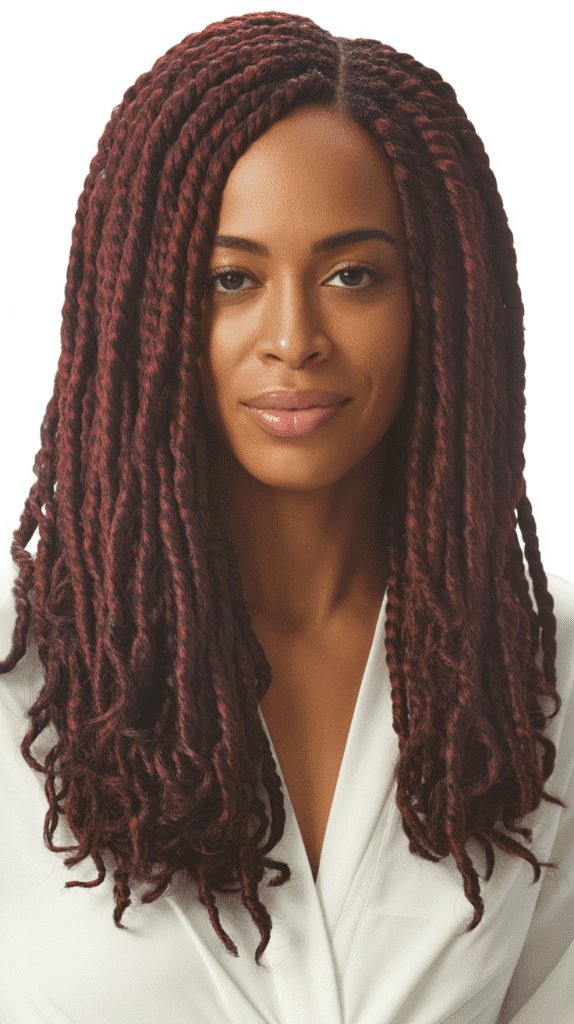
Senegalese twists involve wrapping two strands of hair around each other to create smooth, rope-like twists that hang beautifully.
Unlike braiding, twisting requires wrapping the hair consistently in one direction, resulting in a distinctive texture that’s both elegant and low-maintenance.
Characteristics and Appeal
- Senegalese twists have a sleeker, more uniform appearance than braids due to the wrapping technique used in their creation.
- The style typically uses Kanekalon or Marley hair extensions, with Kanekalon creating smoother, shinier twists.
- These twists are versatile enough for casual daily wear yet sophisticated enough for professional and formal settings.
- The installation process is often faster than braiding, making Senegalese twists a time-efficient protective style option.
Maintenance and Longevity
- Senegalese twists can last six to eight weeks when properly maintained with regular moisturizing and nighttime protection.
- Apply a light oil or braid spray to the twists weekly to maintain shine and prevent the synthetic hair from becoming dry.
- Sleep with a satin bonnet or on a satin pillowcase to minimize frizzing and preserve the smooth texture of your twists.
- Refresh your edges and hairline as needed with edge control to keep your style looking fresh throughout the weeks.
7. Havana Twists
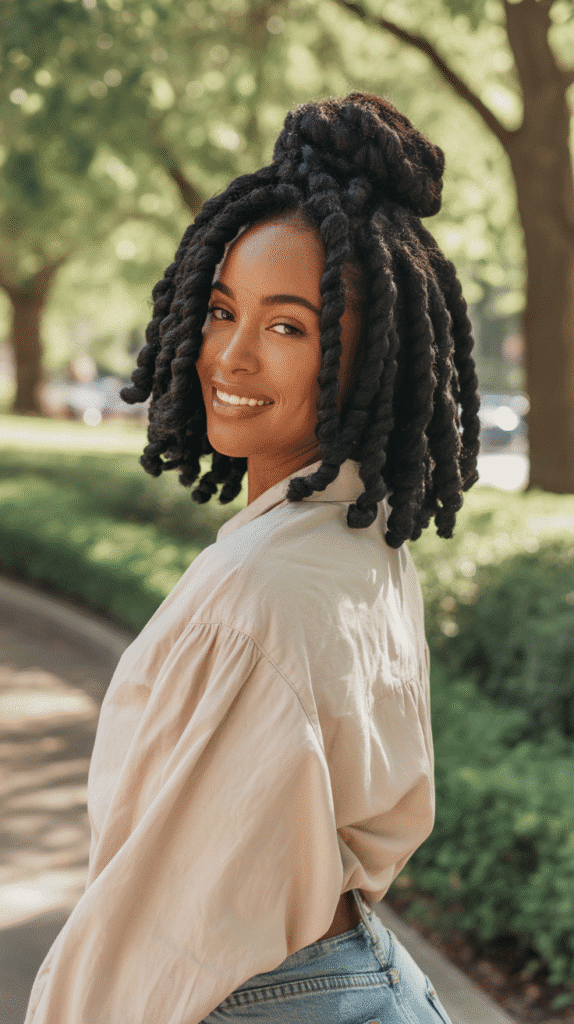
Havana twists are chunkier, more voluminous versions of Senegalese twists, typically created with Havana or Marley hair for a fuller, more textured appearance.
These twists offer a bold, statement-making look while still providing the protective benefits and versatility of twisted styles.
Distinctive Features
- Havana twists use thicker sections of hair and fuller extensions, creating a more dramatic, voluminous style than thinner twists.
- The texture of Havana or Marley hair gives these twists a more natural, slightly fuzzy appearance that mimics natural hair texture.
- The chunky size means fewer individual twists are needed, resulting in faster installation times compared to smaller twists.
- These twists have significant presence and make a bold fashion statement while remaining practical and protective.
Styling Ideas
- Wear your Havana twists in a high top knot for a casual yet stylish everyday look that keeps hair off your face.
- Create a side-swept style by gathering all twists to one side for an asymmetrical, glamorous appearance.
- Style half of your twists up while leaving the rest down for a balanced look that works for various occasions.
- Add a headband or scarf woven through your twists to add color and personality while keeping them secure.
8. Marley Twists
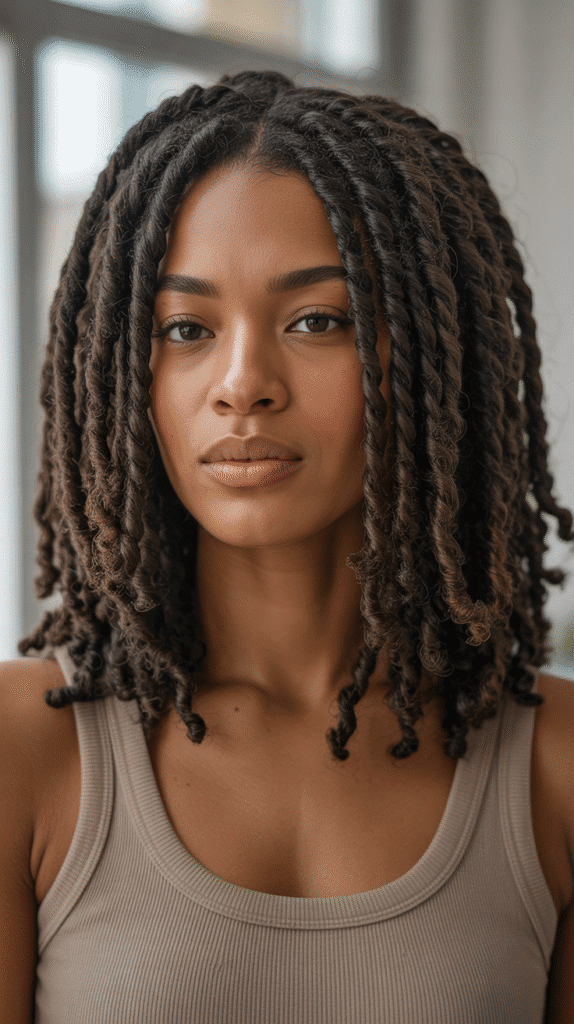
Marley twists closely resemble natural hair texture due to the kinky, coarse texture of Marley hair extensions.
This style offers a more authentic, natural-looking protective style that blends seamlessly with textured hair and celebrates natural beauty.
Why Choose Marley Hair
- Marley hair’s kinky texture creates twists that look incredibly natural and blend beautifully with afro-textured hair.
- The coarser texture provides better grip during installation, making the twists more secure and longer-lasting.
- Marley twists embrace and celebrate natural hair texture rather than trying to create an artificially smooth appearance.
- This hair type allows for versatile styling while maintaining a look that feels authentic and true to natural hair aesthetics.
Care Instructions
- Moisturize your Marley twists regularly with a water-based spray to prevent the hair from becoming dry and brittle.
- Avoid excessive manipulation or pulling on the twists to maintain their integrity and prevent premature frizzing.
- Use a hooded dryer or air-dry after moisturizing to prevent mildew in the dense, textured hair.
- Remove Marley twists carefully after six to eight weeks, gently unraveling them to avoid damaging your natural hair underneath.
9. Ghana Braids

Ghana braids, also known as banana braids or Cherokee braids, are cornrows that start thin at the hairline and gradually become thicker by continuously adding extensions throughout the braid.
This creates a distinctive tapered look with impressive thickness and dimension.
Unique Characteristics
- Ghana braids feature a dramatic size progression from thin roots to thick, full braids that create striking visual impact.
- The continuous feed-in technique creates a raised, almost 3D effect that makes the braids stand out from the scalp.
- These braids are particularly versatile for creating elaborate updos and sculptural styles due to their thickness and structure.
- The style combines the protective benefits of cornrows with the bold aesthetic of jumbo braids.
Styling Versatility
- Create a Ghana braid crown by braiding large sections around your head’s perimeter for a regal, halo effect.
- Style Ghana braids into a large, dramatic bun that showcases the braids’ impressive thickness and creates a statement look.
- Wear four to six large Ghana braids straight back for a bold, low-maintenance style that lasts several weeks.
- Combine Ghana braids with loose hair or curls in the back for a mixed-texture style that’s both protective and glamorous.
10. Jumbo Braids

Jumbo braids are oversized box braids that use thick sections of hair and substantial extensions to create bold, voluminous styles.
These eye-catching braids make a strong fashion statement while being practical and protective, with the added benefit of faster installation due to their larger size.
Advantages of Going Big
- Jumbo braids require significantly less installation time than smaller braids, often completed in three to five hours.
- The larger size creates a bold, confident aesthetic that stands out and makes a memorable impression.
- Despite their size, jumbo braids remain lightweight and comfortable for extended wear when properly installed.
- The thick sections protect large portions of your natural hair while allowing your scalp to breathe more easily.
Color and Length Options
- Experiment with ombre effects by using extensions that transition from dark roots to lighter tips for dimensional color.
- Try vibrant colors like burgundy, purple, or blue for a dramatic, fashion-forward look that expresses your personality.
- Choose shoulder-length jumbo braids for a practical, manageable style or go waist-length for maximum drama.
- Combine multiple complementary colors in different braids for a multi-tonal effect that adds depth and interest.
11. Tribal Braids
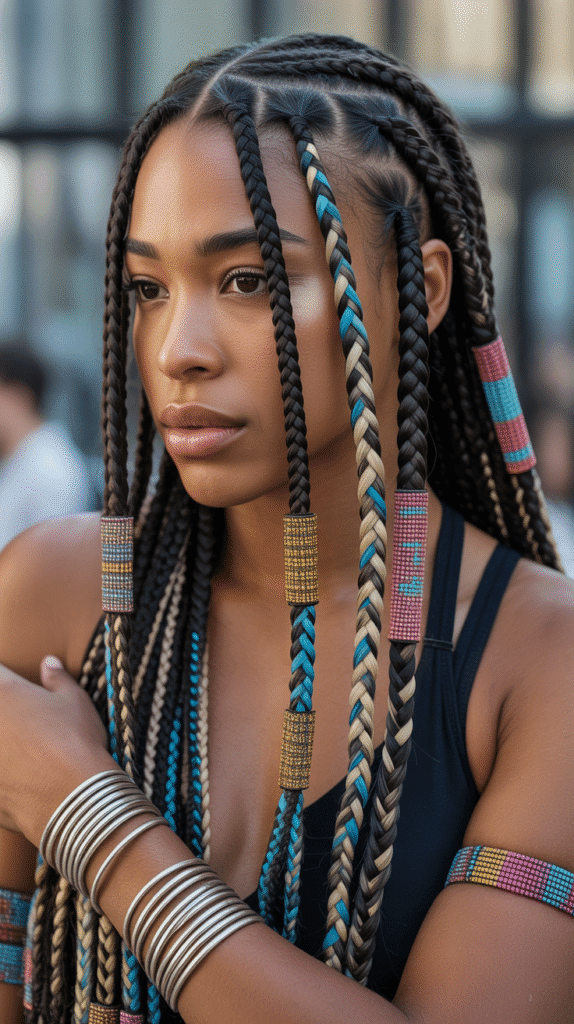
Tribal braids encompass various braiding styles inspired by different African tribes, featuring intricate patterns, unique parting designs, and often incorporating beads, thread, or other decorative elements.
These styles celebrate cultural heritage while offering creative expression and protective benefits.
Design Elements
- Tribal braids often incorporate multiple techniques within one style, combining cornrows, box braids, and feed-in methods.
- Geometric and asymmetrical parting patterns create visual interest and showcase the artistry involved in the style.
- Decorative elements like wooden beads, metal cuffs, colored thread, and cowrie shells add cultural significance and personalization.
- The braids may vary in size throughout the head, creating texture and dimension that makes the style unique.
Cultural Connection
- Tribal braids honor specific African cultural traditions while allowing for modern interpretation and personal creativity.
- Many tribal braid patterns carry historical significance related to social status, marital status, or tribal affiliation.
- Wearing tribal braids with cultural awareness and respect acknowledges the rich heritage behind these beautiful styles.
- Contemporary tribal braids blend traditional elements with modern aesthetics, creating styles that are both meaningful and fashionable.
12. Lemonade Braids
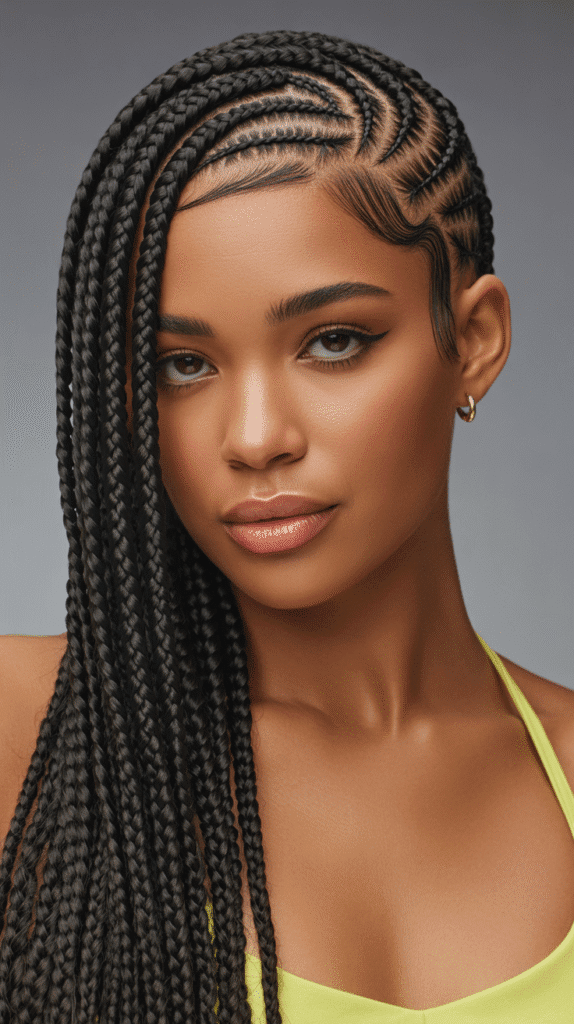
Lemonade braids gained mainstream popularity through Beyoncé’s “Lemonade” visual album, featuring side-swept cornrows of varying sizes that cascade to one side.
This asymmetrical style combines elegance with edge, creating a look that’s both feminine and bold.
Style Specifications
- Lemonade braids typically feature smaller, medium, and larger cornrows grouped together on one side of the head.
- The braids are usually done using the feed-in technique for a natural-looking hairline and reduced tension.
- The asymmetrical sweep creates a dynamic, fashion-forward silhouette that flatters most face shapes.
- The style works beautifully with various lengths, from shoulder-grazing to waist-length braids.
Maintenance and Styling
- Sleep with your braids tucked into a satin bonnet or scarf to maintain the side-swept direction and prevent frizzing.
- Apply edge control daily to keep your hairline sleek and your baby hairs styled to perfection.
- Refresh the style by gently pulling the braids back to the desired side if they shift during sleep.
- Add shine spray or light oil to keep the braids looking lustrous and fresh throughout the weeks of wear.
13. Micro Braids

Micro braids are extremely thin braids, typically about the width of a pencil lead or smaller, that create a dense, flowing style resembling natural hair movement.
While installation is time-intensive, micro braids offer incredible versatility and can last up to three months with proper care.
Installation Considerations
- Micro braids require significant time investment, often taking eight to fourteen hours or multiple sessions to complete.
- The tiny size means hundreds or even thousands of individual braids, requiring patience from both stylist and client.
- Professional installation is strongly recommended due to the precision and expertise required for consistent, healthy micro braids.
- The extended installation time is balanced by the style’s longevity and incredible versatility once complete.
Styling Possibilities
- Wear micro braids in a high ponytail for a sleek, elegant look that showcases the braids’ flow and movement.
- Create intricate updos and buns using the tiny braids’ flexibility to achieve styles impossible with thicker braids.
- Style micro braids in loose curls by braiding sections overnight or using perm rods for added texture.
- Wear your hair down for a natural, flowing appearance that moves beautifully and resembles loose natural hair.
14. Crochet Braids
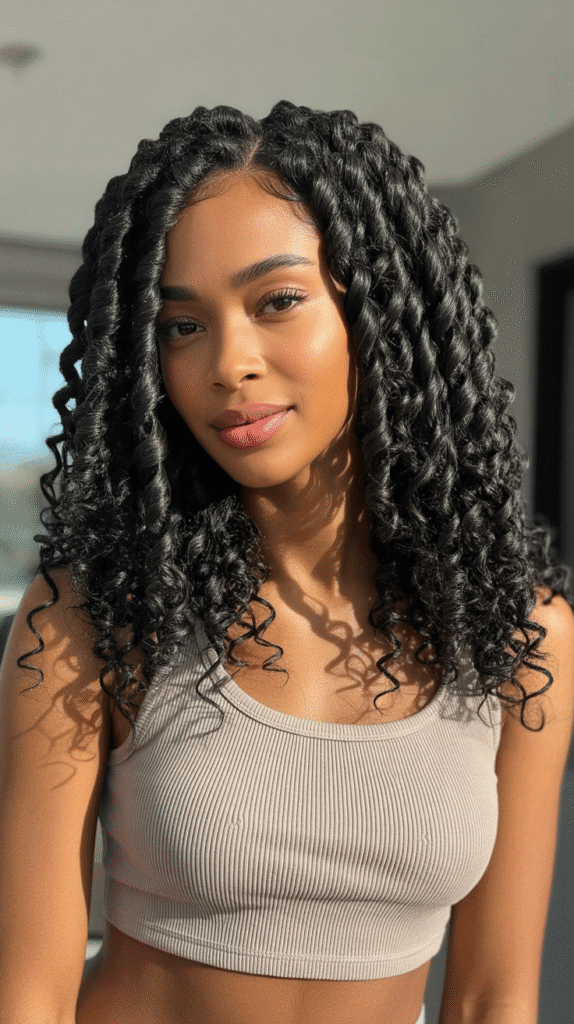
Crochet braids involve cornrowing your natural hair and then using a crochet hook to loop pre-braided or twisted hair extensions through the cornrows.
This technique offers quick installation, minimal tension, and endless styling options with various hair textures available.
Method and Benefits
- Crochet installation is significantly faster than traditional braiding, often completed in two to four hours.
- The technique places minimal tension on your natural hair since the extensions are looped through rather than braided in.
- You can achieve various looks using different crochet hair types, from straight to wavy to tightly coiled textures.
- Crochet braids allow easy access to your scalp for cleansing and moisturizing, promoting healthier hair maintenance.
Hair Texture Options
- Choose curly crochet hair for voluminous, bouncy styles that resemble natural curl patterns and wash-and-go looks.
- Select straight crochet hair for sleek, flowing styles that mimic pressed or relaxed hair textures.
- Try twist or braid-patterned crochet hair for instant protective styles without spending hours in the braiding chair.
- Experiment with different lengths, from short bobs to long, dramatic lengths, by simply changing the hair extensions used.
15. Goddess Braids

Goddess braids are thicker, more prominent braids that are often styled in simple patterns like two to four large cornrows.
These braids create a regal, elevated look that’s both practical and beautiful, working well for formal events or casual everyday wear.
Styling Characteristics
- Goddess braids are typically larger and more prominent than standard cornrows, making them quick to install and impactful.
- The style often features just two to four braids total, creating a clean, uncomplicated aesthetic that emphasizes simplicity.
- These braids can be styled straight back, in a crown pattern, or into updos for different occasions and preferences.
- The thickness and structure of goddess braids make them ideal for adding extensions for length or volume.
Variations and Accessories
- Add curly or wavy hair at the ends of goddess braids for a romantic, goddess-inspired finish that softens the look.
- Weave colored thread or metallic string through the braids for added visual interest and personalized style.
- Create a goddess braid crown by braiding around the perimeter of your head for an ethereal, halo effect.
- Incorporate beads or cuffs at strategic points along the braids to add elegance and secure any added hair.
16. Tree Braids

Tree braids combine cornrows with loose extension hair that’s left out at the ends, creating the appearance of natural hair growing from your scalp.
This style offers the protection of braided roots with the versatility and movement of loose hair.
Technique and Appearance
- The cornrow base is kept small and close to the scalp, with most of the extension hair left loose and unbraided.
- Tree braids create an extremely natural appearance since the cornrows are hidden beneath the loose hair.
- The style allows you to enjoy the protective benefits of braids while having the versatility of loose, flowing hair.
- Various hair textures can be used, from straight to wavy to curly, depending on your desired final look.
Styling and Maintenance
- Style tree braids just like you would loose natural hair, using rollers, flexi-rods, or braiding for different textures.
- The loose hair requires moisturizing and maintenance similar to wearing a weave or your natural hair out.
- Sleep with a satin bonnet to protect both the cornrow base and the loose hair from tangling and frizzing.
- Tree braids typically last four to six weeks before the loose hair becomes too tangled or the cornrows need redoing.
17. Passion Twists
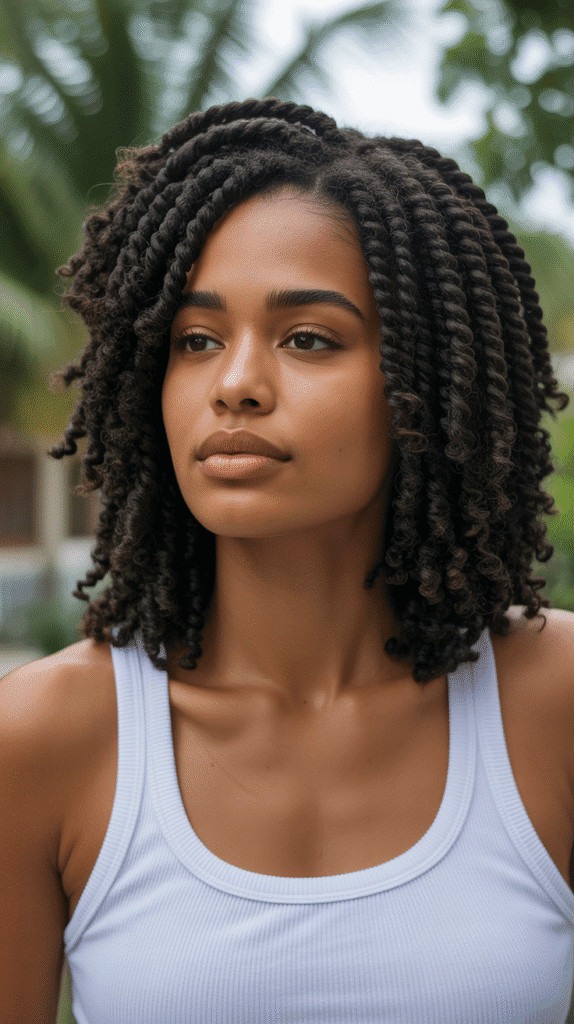
Passion twists are a newer protective style featuring spring-like twists with a bohemian, carefree aesthetic.
Created using water wave hair, these twists have a distinctive curly texture that sets them apart from traditional Senegalese or Havana twists.
Unique Qualities
- Passion twists use water wave or passion twist hair, which has a pre-curled texture that creates the style’s signature look.
- The curly texture gives passion twists a softer, more romantic appearance than smoother twist styles.
- These twists are lighter than many other protective styles, making them comfortable for extended wear and active lifestyles.
- The bohemian aesthetic of passion twists works beautifully for casual, beachy, or festival-inspired looks.
Installation and Care
- Passion twists are installed using a two-strand twist method, with the textured hair creating the curly appearance.
- The style typically takes four to eight hours to install, depending on the desired length and thickness.
- Moisturize passion twists regularly with a light spray to maintain the hair’s texture and prevent dryness.
- These twists generally last six to eight weeks but may become frizzy sooner due to their textured nature.
18. Butterfly Locs

Butterfly locs are a distressed loc style created using the crochet method, featuring intentionally messy, looped texture that creates a lived-in, bohemian aesthetic.
Despite their undone appearance, butterfly locs are a deliberate, protective style that’s gained significant popularity.
Style Characteristics
- Butterfly locs feature intentional loops, bubbles, and texture that create a deliberately imperfect, artistic appearance.
- The style is achieved through crochet installation, making it faster and less permanent than traditional locs.
- Despite the messy aesthetic, butterfly locs still provide protective benefits by keeping natural hair tucked away.
- The bohemian look works particularly well for artistic, creative, or free-spirited personal styles.
Creating the Look
- Butterfly locs are installed by crocheting distressed loc extensions through cornrowed natural hair.
- The stylist intentionally creates loops and loose sections during installation to achieve the signature butterfly effect.
- The style can be customized with different levels of distressing, from subtly textured to dramatically looped.
- Color variations and ombre effects work beautifully with butterfly locs, enhancing their dimensional, textured appearance.
19. Stitch Braids
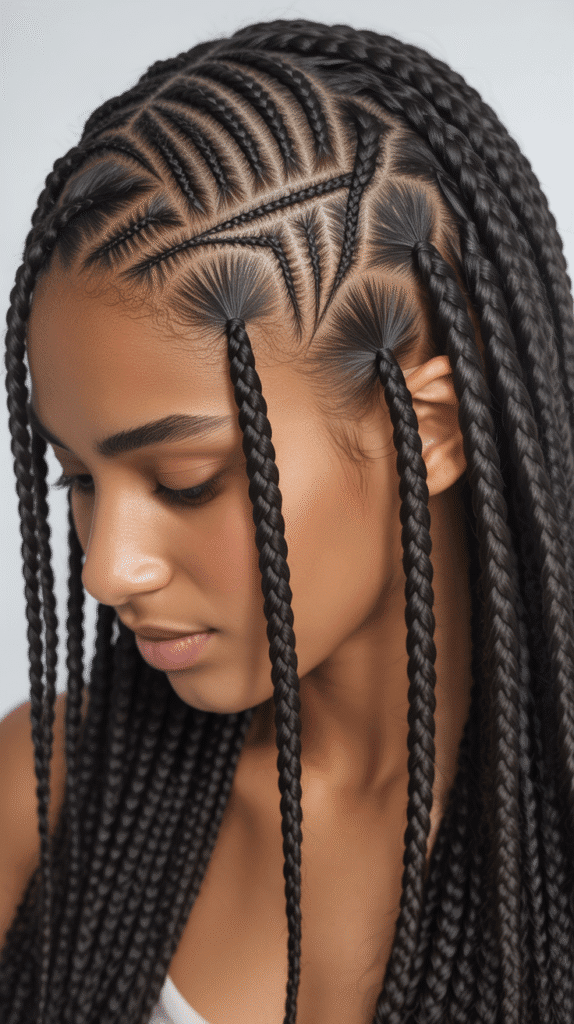
Stitch braids feature a distinctive horizontal or diagonal parting pattern that resembles stitching, created by making small, precise parts between each cornrow.
This style combines the sleekness of cornrows with an artistic, geometric element that elevates the overall look.
Defining Features
- The “stitch” effect is created by making small, evenly spaced horizontal parts between each cornrow during installation.
- Stitch braids require exceptional precision and skill, resulting in a highly polished, professional appearance.
- The geometric parting pattern adds visual interest while maintaining the clean aesthetic of traditional cornrows.
- This style showcases the braider’s artistry and attention to detail, making it a true hair art form.
Styling Options
- Straight-back stitch braids create a sleek, uniform look perfect for professional settings or formal occasions.
- Side-swept stitch braids add asymmetry and modern flair while maintaining the style’s signature precision.
- Combine stitch braids with box braids by using the stitch technique for the front cornrows and adding box braids in the back.
- Create an updo using stitch braids that converge at the crown, showcasing the geometric pattern from all angles.
20. Bubble Braids
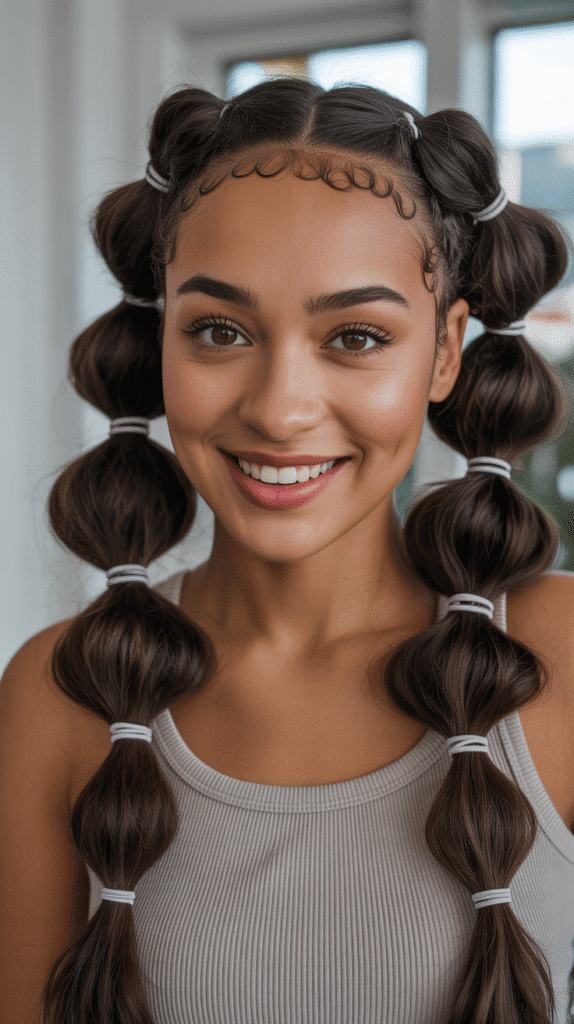
Bubble braids create a playful, segmented appearance by sectioning braids or ponytails with elastic bands at regular intervals, creating “bubbles” of hair between each band.
This fun, youthful style works with your natural hair or extensions and requires minimal time to create.
Creating Bubble Braids
- Start with one or more ponytails or braids secured at the base with an elastic band.
- Add additional elastic bands down the length of the hair at evenly spaced intervals, typically every two to four inches.
- Gently pull and fluff the hair between each elastic to create the rounded bubble effect.
- The style works with natural hair, extensions, or over existing box braids for varied looks.
Styling Variations
- Create two bubble braids on either side of your head for a cute, symmetrical look reminiscent of childhood styles.
- Make a single high bubble ponytail for a sporty, energetic style perfect for workouts or casual outings.
- Try multiple smaller bubble braids across your head for a more complex, textured appearance.
- Use colorful or decorative elastic bands to add personality and match your outfit or mood.
21. Braided Ponytail
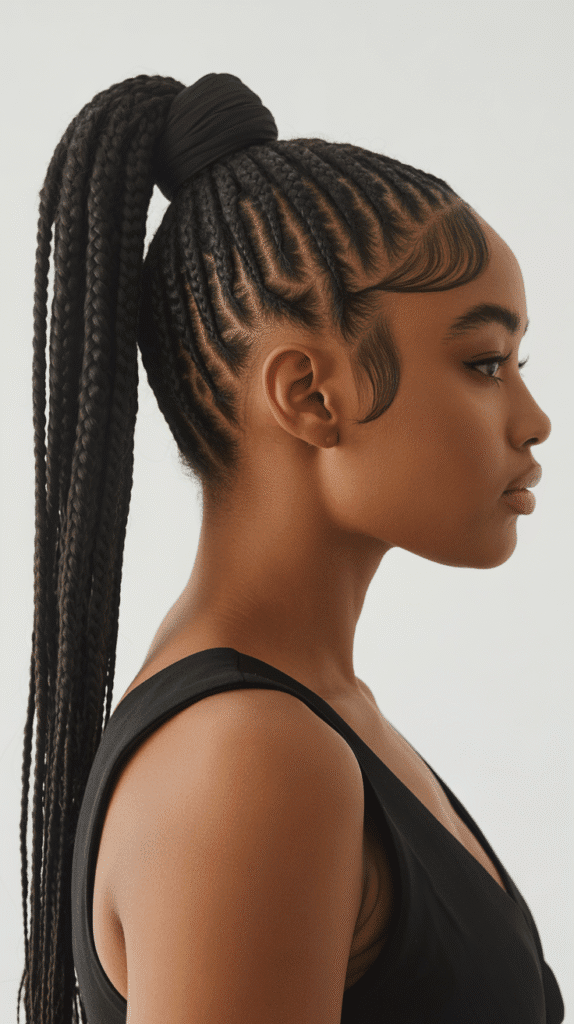
A braided ponytail combines cornrows or other braid techniques with a high or low ponytail, creating a sleek, elegant style that’s both practical and sophisticated.
This versatile look works for everything from gym sessions to formal events.
Style Components
- The front and sides of the hair are typically cornrowed or flat-twisted toward the crown or nape.
- All braids converge at a single point where they’re gathered into a ponytail with or without added extensions.
- The ponytail can be left as loose hair, braided, twisted, or styled with curls depending on preference.
- This style offers the protective benefits of braids with the versatility and movement of a ponytail.
Positioning Options
- High braided ponytails create a youthful, energetic look that lifts the face and elongates the neck.
- Low braided ponytails at the nape offer a sophisticated, polished appearance perfect for professional settings.
- Side braided ponytails add asymmetry and contemporary flair while remaining practical and protective.
- Add a braid or twist wrap around the ponytail base to conceal the elastic and create a polished finish.
22. Zig-Zag Braids
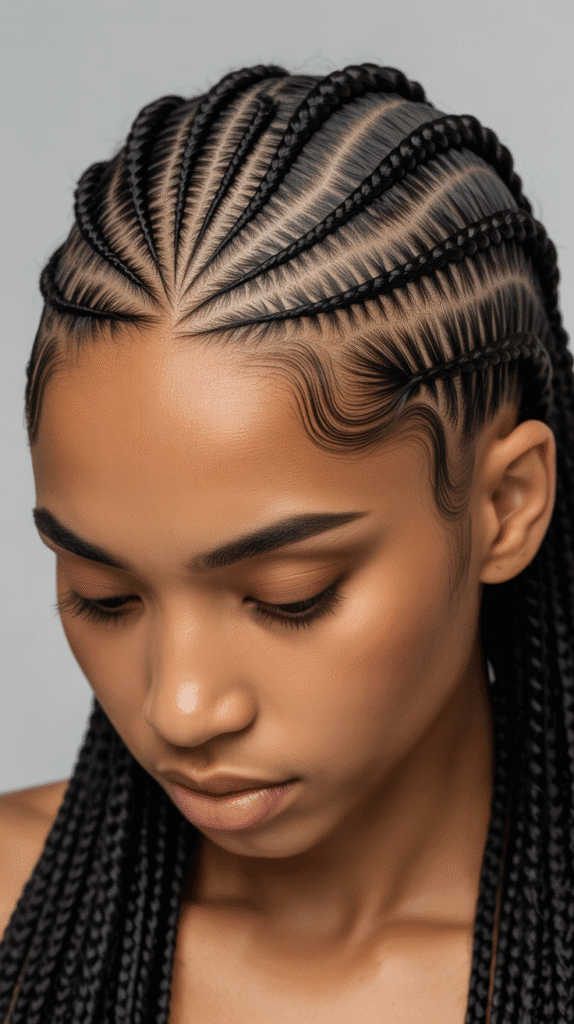
Zig-zag braids feature cornrows that follow a distinctive back-and-forth pattern across the scalp rather than straight lines.
This playful, artistic style adds dimension and visual interest while maintaining all the protective benefits of traditional cornrows.
Design Appeal
- The zig-zag pattern creates visual movement and dynamic energy that makes the style stand out from standard cornrows.
- This style requires skilled braiding and precise parting to achieve clean, uniform zig-zag patterns across the head.
- Zig-zag braids can be combined with straight-back sections for contrast and additional design complexity.
- The geometric pattern adds a playful, youthful element while remaining sophisticated enough for various settings.
Pattern Variations
- Create bold, wide zig-zags for a dramatic, graphic appearance that makes a strong style statement.
- Try subtle, narrow zig-zags for a more understated look that adds texture without overwhelming the style.
- Combine multiple zig-zag patterns in different directions for an intricate, maze-like design across your scalp.
- Add zig-zags only to the front or side sections while keeping the back straight for a mixed-technique approach.
23. Braided Updo
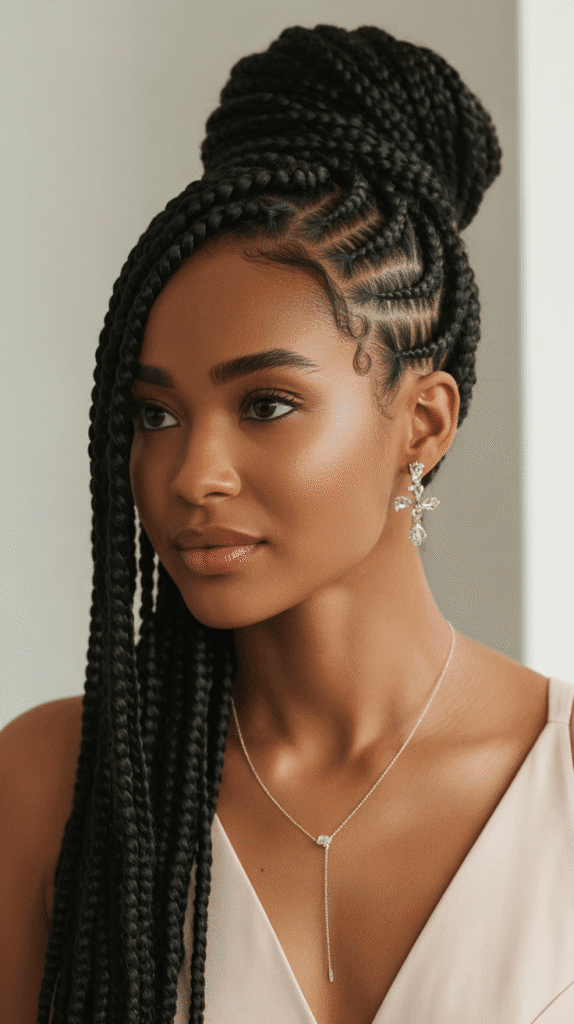
Braided updos gather braids of any type into elegant arrangements at the crown or back of the head, creating sophisticated styles perfect for weddings, formal events, or professional settings.
These versatile styles showcase the beauty of braids while keeping hair completely off the neck and face.
Updo Techniques
- Create a braided bun by wrapping sections of braids around themselves in a circular pattern and pinning securely.
- Design a braided crown by braiding sections around the perimeter of your head for a halo-like effect.
- Style a twisted updo by twisting groups of braids together and pinning them at various angles for dimension.
- Make a low braided chignon by gathering braids at the nape and arranging them into an elegant, sophisticated shape.
Occasion Styling
- Wedding updos can incorporate decorative pins, flowers, or metallic accessories for extra glamour and personalization.
- Professional braided updos keep the style polished and neat while showcasing your personal style in work settings.
- Casual updos offer a quick way to change your look and keep braids off your neck during hot weather.
- Formal event updos can be elaborate and time-intensive, creating one-of-a-kind styles for special occasions.
24. Braided Bob

A braided bob features shorter braids that end at chin, jaw, or shoulder length, creating a chic, manageable style that’s both trendy and practical.
This contemporary take on classic bob haircuts works with various braid types for different aesthetic effects.
Style Benefits
- Braided bobs offer all the protective benefits of longer braids while being lighter and easier to manage daily.
- The shorter length dries faster after cleansing and requires less manipulation during styling and maintenance.
- This style creates a fresh, modern aesthetic that works beautifully in professional and casual settings alike.
- Braided bobs frame the face beautifully and work with most face shapes when cut at the appropriate length.
Length and Cut Options
- Chin-length braided bobs create a classic, sophisticated silhouette that draws attention to your jawline and neck.
- Shoulder-length versions offer slightly more versatility while maintaining the bob’s manageable, practical nature.
- Asymmetrical braided bobs feature one side longer than the other for an edgy, fashion-forward appearance.
- Blunt-cut ends create a sharp, modern finish while angled cuts add movement and dimension to the style.
25. Mixed Braid Styles

Mixed braid styles combine two or more braiding techniques in one look, creating unique, personalized styles that showcase creativity and individuality.
These combinations offer the best features of multiple styles while creating something entirely new and distinctive.
Popular Combinations
- Cornrows with box braids combine sleek, flat-braided sides with fuller box braids through the crown and back sections.
- Braids with twists alternate between braiding and twisting techniques throughout the head for varied texture and dimension.
- Braids with loose ends feature fully braided roots that transition to loose, flowing hair at the ends for romantic appeal.
- Half-braided, half-natural styles protect part of the hair while leaving other sections in their natural state for versatility.
Creative Possibilities
- Experiment with different braid sizes within one style, mixing micro, medium, and jumbo braids for textural contrast.
- Combine different colors in various sections, using multiple shades to create a multi-dimensional, artistic effect.
- Mix decorative elements throughout, adding beads to some braids while leaving others plain for balanced visual interest.
- Layer different techniques by starting with cornrows that transition into box braids or twists for seamless style evolution.
Maintenance Tips for All Braided Styles
Proper maintenance extends the life of your braids while keeping your natural hair healthy underneath.
Following consistent care routines ensures your protective style remains beautiful and continues serving its protective purpose throughout its wear time.
Daily and Weekly Care
- Wrap your braids in a satin or silk scarf or bonnet every night to minimize frizzing and preserve the style’s neatness.
- Apply lightweight oil to your scalp two to three times weekly to prevent dryness and maintain healthy scalp conditions.
- Moisturize your braids with a water-based braid spray to keep both the extensions and your natural hair hydrated.
- Avoid excessive pulling or tension on your edges and hairline to prevent traction alopecia and hair loss.
Cleansing and Scalp Health
- Cleanse your scalp every one to two weeks using diluted shampoo applied with an applicator bottle or cotton pads.
- Focus cleaning efforts on the scalp rather than the length of braids to remove buildup without causing frizz.
- Allow your braids to air-dry completely after cleansing to prevent mildew, odor, or damage to your natural hair.
- Use witch hazel on cotton pads between washes to refresh your scalp and remove excess oil or product buildup.
When to Remove Braids
- Most braided styles should be removed after six to eight weeks to prevent matting, loc formation, and scalp issues.
- Remove braids sooner if you experience excessive itching, pain, or signs of buildup that won’t resolve with cleansing.
- Never keep braids in longer than three months, even if they still look good, to maintain hair and scalp health.
- Schedule removal when you have adequate time for careful unbraiding, detangling, and deep conditioning your natural hair.
Choosing the Right Braid Style for You
Selecting the perfect braided hairstyle depends on multiple factors including your lifestyle, hair health, face shape, and personal aesthetic preferences.
Understanding these elements helps you make informed decisions that result in styles you’ll love and that work for your unique needs.
Lifestyle Considerations
- Active lifestyles benefit from secure styles like cornrows, feed-in braids, or braided ponytails that stay neat during workouts.
- Professional environments may call for more polished styles like goddess braids, sleek updos, or classic box braids in neutral colors.
- Low-maintenance preferences align well with larger braids like Havana twists, jumbo braids, or goddess braids requiring less styling time.
- Social and creative lifestyles can embrace bold colors, mixed techniques, and decorative elements for maximum self-expression.
Face Shape Guidelines
- Round faces look stunning with height-adding styles like high ponytails, top knots, or styles with volume at the crown.
- Oval faces are versatile and work well with virtually any braid style from sleek cornrows to voluminous twists.
- Square faces soften beautifully with side-swept styles, curved braids, or styles with curly or wavy elements at the ends.
- Heart-shaped faces balance well with styles that add volume at the jawline or feature braids that frame the face.
Hair Health Factors
- Fine or fragile hair benefits from lighter styles like knotless braids, feed-in braids, or medium-sized twists with minimal tension.
- Thick, dense hair can handle heavier extensions and larger braid styles without experiencing excessive weight or strain.
- Damaged edges require extra-gentle styles avoiding tension at the hairline, such as halo braids or styles starting further back.
- Shorter natural hair works well with crochet braids, shorter protective styles, or braids that don’t require excessive stretching.
Styling Accessories and Embellishments
Accessories transform basic braided styles into personalized, eye-catching looks that express your unique style and creativity.
From traditional beads to modern cuffs, the right embellishments add dimension, color, and cultural significance to your braids.
Traditional and Cultural Accessories
- Cowrie shells carry deep cultural significance and add natural, earthy beauty to styles like Fulani or tribal braids.
- Wooden beads in various sizes and colors provide traditional African-inspired decoration that honors cultural heritage.
- Gold or metallic rings and cuffs add elegance and shine while securing braids and creating polished finishing touches.
- Colorful thread wrapped around braids creates vibrant patterns and allows for intricate color combinations and designs.
Modern Embellishments
- Hair jewelry including decorative pins, clips, and barrettes adds sparkle and sophistication for special occasions.
- Ribbons and fabric strips woven through braids create soft, romantic effects perfect for festivals or creative styling.
- Clear or colored elastic bands create bubble effects or secure styles while adding subtle decorative elements.
- Metallic leaf or geometric accessories provide contemporary, fashion-forward accents that elevate simple braid styles.
Color Options for Braided Styles
Adding color to your braids allows for dramatic transformations and creative expression without permanently dyeing your natural hair.
Extension colors range from natural tones to vivid fashion shades, offering endless possibilities for personalization.
Natural Color Options
- Jet black provides classic, timeless elegance that works in any setting and complements all skin tones beautifully.
- Dark browns offer subtle warmth while maintaining a professional, natural appearance suitable for conservative environments.
- Warm browns and auburn shades add dimension and richness that enhance deeper skin tones with golden undertones.
- Honey and caramel tones create sun-kissed effects that brighten the face and work beautifully with warmer complexions.
Fashion Color Choices
- Burgundy and wine shades provide rich, sophisticated color that’s bold without being overly dramatic or impractical.
- Blues ranging from navy to electric create striking, artistic statements perfect for creative personal styles.
- Purples and plums offer regal, luxurious tones that work surprisingly well with various skin tones and occasions.
- Blonde shades from platinum to golden create high-contrast, attention-grabbing looks that make powerful style statements.
Ombre and Multi-Tonal Effects
- Dark roots transitioning to lighter ends create natural-looking dimension and the appearance of sun-lightened hair.
- Contrasting two-tone combinations like black-and-burgundy or brown-and-blonde create dramatic, fashion-forward effects.
- Multiple color mixing throughout uses various shades in different braids for complex, multi-dimensional coloring.
- Subtle highlighting with colors just a few shades lighter than your base adds depth without dramatic contrast.
Professional vs. DIY Braiding
Deciding whether to visit a professional braider or attempt braiding at home depends on your skill level, the style’s complexity, available time, and budget considerations.
Understanding the advantages of each approach helps you make the best choice for your situation.
Benefits of Professional Braiding
- Professional braiders possess specialized skills and years of experience creating consistent, long-lasting, and beautifully installed braids.
- Complex styles like intricate cornrow patterns, precise stitch braids, or elaborate updos require professional expertise for best results.
- Professionals work efficiently, completing styles in less time than DIY attempts while maintaining quality and precision.
- Licensed braiders understand proper tension, hair health principles, and techniques that prevent damage or discomfort.
DIY Braiding Considerations
- Simple styles like basic box braids, two-strand twists, or braided ponytails can be learned and executed at home with practice.
- DIY braiding saves money over time, especially for those who regularly wear protective styles and change them frequently.
- Braiding your own hair allows complete creative control and the ability to work at your own pace without time pressure.
- Learning to braid develops a valuable skill that provides independence and deeper understanding of hair care practices.
Finding a Quality Braider
- Research local braiders through social media platforms like Instagram where they showcase their work and recent styles.
- Read reviews and ask for recommendations from friends or online community groups focused on natural hair care.
- Schedule consultations to discuss your desired style, assess the braider’s professionalism, and view their portfolio in person.
- Verify that braiders prioritize hair health, use appropriate tension, and maintain clean, professional working environments.
Cost Considerations for Braided Styles
Understanding the financial investment required for various braided styles helps you budget appropriately and make informed decisions.
Costs vary significantly based on style complexity, hair length, geographic location, and whether you provide your own extensions.
Cost Factors
- Geographic location significantly impacts pricing, with urban areas and high-demand regions typically charging premium rates.
- Hair length and thickness affect both installation time and the amount of extension hair needed, directly influencing cost.
- Braider experience and reputation justify higher prices, with sought-after stylists commanding premium fees for their expertise.
- Additional elements like color, decorative accessories, or complex patterns increase costs beyond base style prices.
Budget-Friendly Options
- Provide your own extension hair purchased from beauty supply stores to reduce costs by $50 to $100 per style.
- Choose styles with faster installation times like cornrows, goddess braids, or crochet braids to minimize labor costs.
- Learn to maintain and refresh styles yourself between professional installations to extend wear time and get better value.
- Consider slightly simpler versions of desired styles that achieve similar aesthetics with less time and complexity involved.
Hair Growth and Health While Braided
Braided protective styles can promote healthy hair growth when installed and maintained properly, but they can also cause damage if done incorrectly or kept too long.
Understanding how to maximize growth and health while wearing braids ensures your protective style truly protects.
Growth-Promoting Practices
- Keep your scalp moisturized with lightweight oils containing ingredients like jojoba, sweet almond, or grapeseed oil.
- Maintain proper nutrition with adequate protein, vitamins, and hydration to support healthy hair growth from within.
- Minimize tension during installation by requesting that your braider uses gentle hands and avoid excessively tight braiding.
- Take breaks between protective styles, allowing your hair at least one to two weeks of rest before reinstalling.
Avoiding Damage
- Never ignore pain or excessive tightness during or after installation, as this indicates damaging tension on your follicles.
- Remove braids at the first sign of significant matting, loc formation, or extensive buildup that won’t cleanse properly.
- Avoid styles that pull heavily on your edges and hairline, as this area is particularly vulnerable to traction alopecia.
- Don’t add extremely heavy or long extensions to fine or fragile hair that cannot support the additional weight.
Post-Braid Hair Care
- Deep condition your natural hair thoroughly after removing braids to restore moisture and repair any damage from protection.
- Gently detangle using your fingers first, then a wide-tooth comb, working from ends to roots to minimize breakage.
- Trim any split ends or damaged tips before installing new protective styles to prevent further splitting and breakage.
- Give your hair recovery time with low-manipulation styles or wearing it loose before installing another protective style.
Conclusion
“25 Simple Braided Hairstyles for Black Women” offers a comprehensive exploration of protective styling options that celebrate natural beauty while promoting hair health and versatility.
From timeless classics like box braids and cornrows to contemporary favorites like passion twists and butterfly locs, these styles provide endless opportunities for self-expression, cultural connection, and practical hair management.
Whether you prefer the boldness of jumbo braids, the elegance of goddess braids, or the artistic flair of tribal patterns, there’s a braided style perfectly suited to your lifestyle, face shape, and personal aesthetic.
Remember that successful braiding combines proper installation technique, consistent maintenance, attention to hair health, and celebration of the rich cultural heritage these styles represent.
By choosing styles that work for your unique needs and caring for them appropriately, you’ll enjoy beautiful, protective hairstyles that make you feel confident, stylish, and connected to the timeless art of African braiding traditions.
Embrace the versatility, experiment with different techniques and embellishments, and most importantly, wear your braids with pride and joy knowing they’re protecting your natural hair while showcasing your individual beauty.
